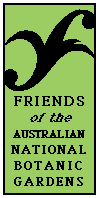Her
husband was a British army officer
who had fought in the Maori wars in New Zealand and later became a
businessman in Melbourne. He encouraged Ellis to continue her wildlife
paintings and to exhibit them.
An important botanical
mentor and role model was the English flower painter and world traveler,
Marianne North, whom the Ryans had met at Albany, W.A. She inspired
in Ellis an ambition "to travel the world in search of flowers
rare and wonderful". Ellis proposed to do this by painting
from life to show flowers in their natural habitat. She embarked
on a succession of major field trips. In 1887, for example, at the
age of 39, she set out on an ambitious scheme to illustrate the
flora of Queensland!
After the death of
her husband in 1892, Ellis Rowan did much travelling overseas, including
to New Zealand, London and the USA During her London stay of two
years, three of her paintings were accepted by Queen Victoria, and
Ellis wrote A Flower Hunter in Queensland and New Zealand.
In the early 1900's she returned to Australia to continue her project
to find and record every species of wildflower on the continent.
Her subjects included, in addition to wildflowers, birds and insects
of many countries. She exhibited her work in Australia, India, England,
Europe and the USA and she was awarded many prizes.
In 1916-18 she twice
visited Papua and New Guinea, finding and illustrating many higher
to unclassified flowers, and on her second trip, searching for endangered
birds of paradise. She painted 47 of the 52 known species. Throughout
her painting career she sent Ferdinand von Mueller, the Government
Botanist in Victoria,m drawings of the wildflowers she found, usually
with samples of the flowers themselves. His annotations are to be
found on the backs of many of her paintings.
Aged 70 and broken
in health from malaria and fatigue, she returned to Australia and
in 1920 held an exhibition of 1000 paintings in Sydney. The next
year, in response to pressures from women's organisations, the Australian
Government, under W.M. Hughes, agreed to purchase the collection.
Argument in the Parliament about the price to be paid was still
in progress when Ellis Rowan died in 1922. In 1923 the Bruce-Page
Government bought 947 paintings for 5000 pounds. These paintings
were possibly about one-third of her prodigious output.
The paintings are now
in the National Library of Australia, Canberra. A selection of these
has been published in Flower Paintings of Ellis Rowan by
Helen Hewson (1982).






